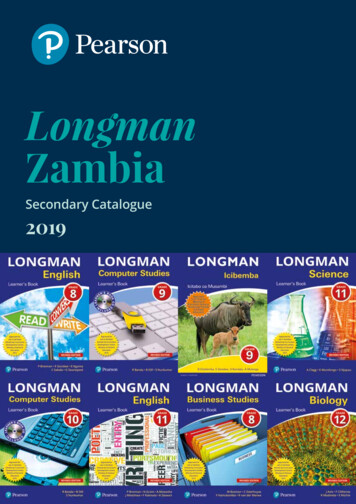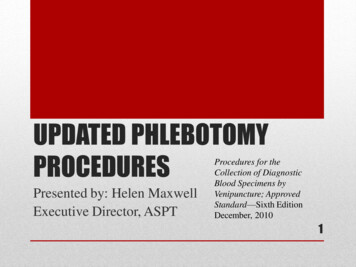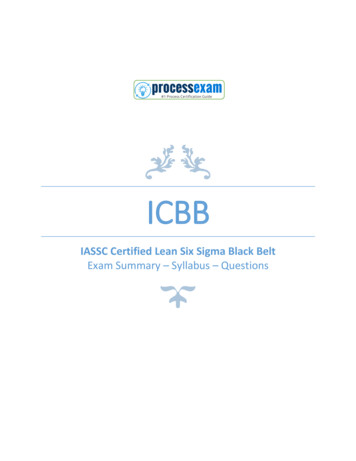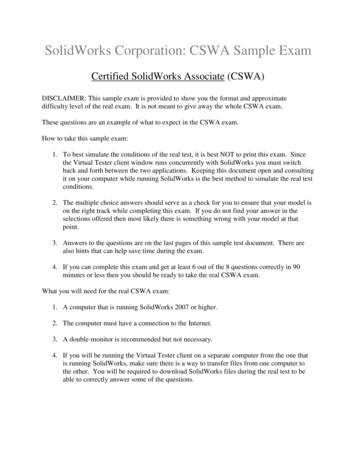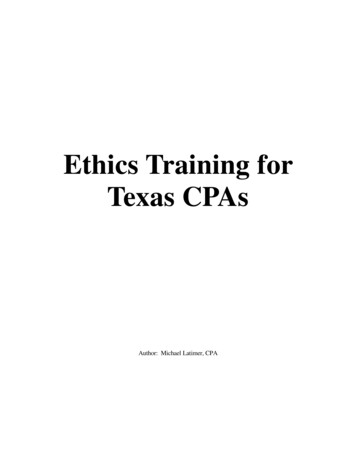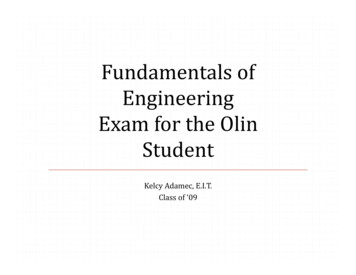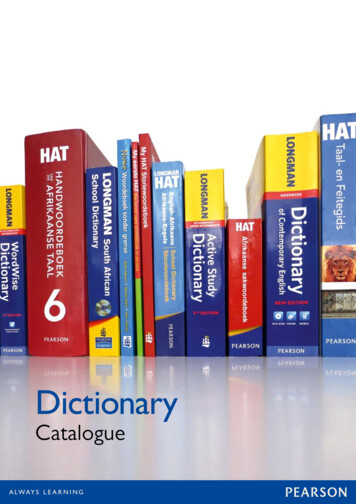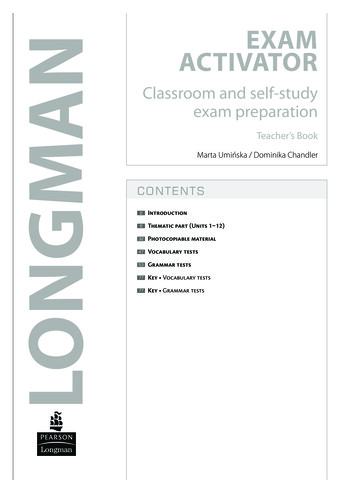
Transcription
LONGMANPrelims act.indd 1ExamactivatorClassroom and self-studyexam preparationTeacher’s BookMarta Umińska / Dominika Chandlercontents2Introduction8Thematic part (Units 1–12)32Photocopiable material47Vocabulary tests53Grammar tests77Key Vocabulary tests77Key Grammar tests10-03-30 13:23:37
IntroductionStudent’s bookReference Part The structure of the Reference Part reflects the structure of a typical exam – a separatesection is devoted to each part of the exam. The Reference Part includes:t information about the structure of a typical exam and an explanation of examstrategiest a functions bank with useful phrases and relevant functional languaget a set of exercises and a typical exam task which can help students put the vocabularyand exam tips into practicet a set of sample writing tasks, text models and extensive lists of useful expressions The Reference Part is primarily intended for self-study. However, as it is closely linked tothe Thematic Part, it can also be used in class. The teacher can refer to it while discussingparticular topics from the Thematic Part.Thematic Part The Thematic Part consists of twelve units covering typical exam topics, which allowsfor organised revision of the material and offers extensive practice of all types of mostcommon exam tasks in a relevant context. It has a definite lesson-like feel to it, offering complete and logical lessons. It is geared towards practical use of the language, avoiding unnecessary repetition ofthe same exam information in each unit of the book. Every unit includes a Wordbank (a list of vocabulary phrases with phonetic transcription)which can be a very useful revision tool before the exam. examworkout tasks help students apply and activate proper exam strategies to solvespecific exam tasks, or provide them with the necessary language to do so. examtask exercises allow students to solve typical exam tasks in an exam-like context. The examworkout and examtask exercises are clearly linked to the strategies from theReference Part.Grammar The Grammar part includes reference sections devoted to the most important grammarpoints and a set of grammar review exercises for each of them. The last exercise in most sections is an Exam Practice task, which sums up a particulargrammar area and shows how a given grammar structure could be used to completevarious types of exam tasks.KeyThe Key section of the Student’s Book contains the answers to the exercises from theReference Part and the Grammar part.TapescriptThe Tapescript contains the scripts of the recordings from the Student’s Book.CDThe CD contains the recordings from the Student’s Book.2Prelims act.indd 210-03-30 13:23:38
Longman Exam Activator – classroom and self-study exam preparationTeacher’s bookThe Teacher’s Book contains references to sections of the Reference Part that can be used inclass while working on the material from the Thematic Part.Thematic Part The Teacher’s Book contains teaching notes for every unit of the Thematic Part, including:t advice on how to set up particular exercisest ideas for warm-up taskst additional speaking and vocabulary exercises and revision activitiest Culture Notes related to topics from the Student’s Bookt the Key to all the exercises from the Thematic Part of the Student’s BookPhotocopiable material This section of the Teacher’s Book contains twelve photocopiable activities (for each unitof the Thematic Part) with detailed teaching notes.The photocopiable exercises are related to the Vocabulary section of each unit.Vocabulary tests This section of the Teacher’s Book contains twelve vocabulary tests with answer keys.Each test is related to one unit from the Thematic Part.Grammar tests This section of the Teacher’s Book contains eighteen grammar tests with answer keys.Each test is related to one grammar point from the Grammar part.3Prelims act.indd 310-03-30 13:23:38
Reference partThis part of the book focuses on the examination itself.It consists of a systematic presentation of each part ofa typical exam which includes requirements, strategiesand advice for candidates as well as sets of practicalexercises and sample examination tasks. As the titlesuggests, it is primarily intended for self-study, providingthe candidates and their teachers with relevant referencematerial whenever they may need it. The colour codingsystem used throughout the book will make this crossreferencing even easier and more effective. On theother hand, the Reference Part can also be used in theclassroom: both strategies and exercises provide theteacher with a lot of useful material which can form partof a lesson or be set as homework.Written examReading comprehensionListening comprehensionThe sections of the book dedicated to listening andreading are structured in a similar way. They both startwith a brief presentation of the listening and readingparts of a typical exam. This is followed by a set of examstrategies which tackle a range of typical problemssuch as ways of dealing with unknown vocabulary oranswering various types of exam tasks. The strategiesare accompanied by exercises designed to provide thecandidates with opportunities to immediately put intopractice some aspects of the ‘theory’ and advice theyhave just been offered.The listening and reading sections then proceed to thepresentation of the most common kinds of examinationtasks. After a brief introduction to each task type, thecandidate is provided with a set of exam strategiesreferring to the given type of task, exercises which includetypical examination tasks and exercises focusing onstrategies needed to deal with specific parts of the task.This kind of awareness-raising activity is particularlyrecommended for classroom use as it can help studentsbuild their skills and confidence for the exam.WritingStarting with a general brief introduction to the writingpart of the examination, this section of the book isthen divided into two sub-sections. The first of themoffers advice and exercise practice focused on writinga short text. Following a range of strategies whichaddress the main challenges in writing this type of text,there is a selection of exercises aiming to graduallybuild the candidate’s writing skills. In its final part, thesub-section also includes models for various types ofshort texts (postcard, announcement, invitation, note)accompanied by a typical exam task and lists of usefulwords, phrases and structures.The other sub-section offers advice and exercise practicefocused on writing a long informative text. Similarly tothe former, it also includes a set of strategies followedby a selection of exercises. At the end of the sub-sectionthere are models for various types of long informativetexts (informal letter, letter of enquiry, letter of complaintand letter of application) including a typical exam taskand lists of useful words, phrases and structures.Spoken examThe most common speaking tasks that the candidatesmay deal with in the spoken part of the exam include:1 General Conversation/Individual Long Turn2 Discussion3 Situational Roleplay4 Photo DescriptionReflecting this sequence, the part of the book dealingwith oral examination is divided into four sub-sectionsdedicated to each of the speaking tasks respectively.Each of the sub-sections begins by introducing a set ofexam strategies and functions of particular relevance tothe task under consideration. This is followed by exercisepractice which aims to target as many of these functionsas possible, and thus encourage the candidate to usethem in a variety of contexts.Use of englishThis section of the Reference Part offers overview of themost common types of exercises which are found inthe Use of English part of the exam. There is a separatesub-section devoted to each type of exam task, offeringa set of exam tips and strategies as well as a selection ofexercises that help the students to apply the strategies inpractice. The last exercise in each section is a typical examtask.4Prelims act.indd 410-03-30 13:23:38
Thematic partThis part of the book is intended mainly as classroommaterial, although there are parts which are best set ashomework.VocabularyAll the Vocabulary sections can be covered in class or setas homework (with the possible exception of listeningand speaking exercises). A mixture of the two willprobably work best. If you want to do the Vocabularysection in class, you may wish to start your lessons withshort vocabulary brainstorming exercises. They shouldhelp you establish what vocabulary your students alreadyknow.If you wish to set the Vocabulary section as homework,you can still ask students to brainstorm vocabularyfrom the different categories at the end of the lesson.Remember to point out that they have got theWordbank to help them with the homework.examworkoutThe Workout tasks are designed to provide guided stepby-step preparation for all types of typical exam tasks.Their role is to offer practice related to specific strategiesor exam tips, or to help analyse the exam task and revisethe language needed to successfully complete it.The Workout tasks contain cross-references to othersections of the book: the Reference Part, the Grammarpart and the Vocabulary sections in the Thematic Part.To achieve best results, it is strongly recommended thatstudents use resources from all parts of the book whenworking on exam tasks.examtaskThese are typical exam tasks. They are not preceded byother exercises referring to the same text or recording,which allows the students to solve the exam tasks in anexam-like context and offers exam practice of each partof the exam in every unit. They are clearly linked to thestrategies from the Reference Part, so if any problemsarise in class, the teacher can easily refer to the theoreticalsection of the book.Reading and listeningThe sections devoted to receptive skills are designed aslesson material. ‘Pure’ exam listening or reading tasks(examtask) are accompanied by a variety of lead-inand follow-up exercises (the latter usually involvingspeaking practice and vocabulary work). If you are shortof time, the reading can be set as homework. If a readingor listening task is preceded by an examworkout, thestrategy or tip practised in the Workout is then usedto answer questions in the main task (examtask).Use of englishThis section of every unit offers a typical exam task. Theexam tasks are introduced either by examworkout tasks,or by lead-in speaking exercises. It is suggested that thesections with the examworkout tasks could be donein class, as they offer a step-by-step guidance on howto apply selected exam strategies when tackling thispart of the exam. The remaining sections can be set ashomework or done in class, depending on students’ andteacher’s needs.SpeakingAll the units contain a SPEAKING section devoted toone of the exam parts. There are also numerous speakingexercises interspersed throughout the book (in Reading,Listening and Use of English sections) which can be usedto practice conversations similar to the first part of theexam. Additionally, there are six clearly referenced PhotoDescription sections to be found at the back of the book.Each section includes a typical exam task (examtask)and an examworkout exercise, the aims of which includeanalysing the exam task and preparing the language andstructures necessary to deal with the exam task using theReference Part, Grammar part and Vocabulary sections.In some cases, one of the students is supposed to take onthe role of the examiner, so the students are encouragedto do the task twice, swapping roles so that both of themcan do the exam task. All speaking sections are definitelyclassroom material.Photo descriptionAll Photo Description sections contain examworkouttasks, focusing on such skills as finding things to sayabout a photo, speculating about the picture, predictingthe examiner’s questions, applying appropriate examstrategies and providing students with relevantvocabulary and functional language. The PhotoDescription sections also include examtask exerciseswhich are typical exam tasks.WritingAll writing sections contain examworkout tasks,the purpose of which is to analyse the exam task and‘collect’ all the language necessary to deal with it. Theexamworkout should be done in class and the writingitself set as homework. After covering a few units, andwhen students are therefore familiar with the structureand purpose of examworkout, it is possible to set thewhole writing section as homework if you are short oftime.&CultureLanguageThroughout all the units, little Language and cultureboxes provide bits of information which lie somewhereon the border between language and culture.5Prelims act.indd 510-03-30 13:23:39
GrammarWhile it is true that grammar is tested directly only inthe Use of English part of the exam, students shouldunderstand that knowledge of grammar contributes toachieving good grades in all parts of both the spoken andwritten exam. It is definitely important to make studentsaware that grammatical accuracy is not the major focusof assessment in the exam, but, at the same time, theyshould realize how grammar impacts on their final grade.The book provides both a grammar reference in English(with examples) and exercises that allow for the practiceof the eighteen most important grammatical points. Thissection of the book can be used very flexibly – eitheras guided work in class or individual work at home. It isalso suitable for mixed-ability/level classes, where somestudents might need more theoretical background andpractice than others. Students’ individual strengthsand weaknesses in the area of grammar can be quicklyassessed while they are doing the Workout tasks. If anydifficulties arise, students are directed to the grammarpoint in question since all tasks contain cross-referencesto other sections of the book. It is also possible toconcentrate on a particular grammar point and make ita focus of one separate grammar revision lesson. Studentscould be asked to do some or all practice exercises in thebook and then be assessed on how they have masteredthe content of the lesson through a short test (providedin the Teacher’s Book).In most sections of this part of the book there isan Exam practice task, which shows how a particulargrammar point should be used to complete a typicalexam task set in either oral or written part of the exam.This exercise is probably the best illustration of howgrammar is interwoven with other language elementsand skills.Longman Exam Activator, page 1896Prelims act.indd 610-03-30 13:23:39
ALL SECTIONS OF THE BOOK ARE COMPLEMENTARY AND OFFER PREPARATION FOR EACH PART OFA TYPICAL EXAM:READING: TRUE/FALSESPEAKING: PHOTO DESCRIPTIONREFERENCE PARTTHEMATIC PARTGRAMMARREFERENCE PART information about the exam andexplanation of exam strategies a set of language functions and usefulexpressions practice exercises and typical examtasks models for various types of writingtasksTHEMATIC PART examworkout tasks offer a step-by-step preparation for the actual examtasks examtask exercises provide exampractice in an exam-like context Vocabulary and Wordbanksections in every unit offer a usefulvocabulary revision toolGRAMMAR grammar structures useful for allparts of the exam grammar theory explained in anapproachable way and presentedwith memorable examples Exam practice tasks show howa particular grammar structure canbe used to complete various types ofexam tasks7Prelims act.indd 710-03-30 13:23:41
1 People, family and social lifeWarm-upThis is a lead-in to the unit. Write on the board: I amhuman because / Humans are wonderful because / Humans are dreadful because Ask the students tocomplete the sentences. Ask for a few responses to beread aloud. If there are quite a few interesting or funnyresponses, you can display them in your room.VocabularyThe whole section can be set as homework. To checkexercises 2 and 7, play the recorded dialogues.Answers2 1 socks 2 sandals 3 underpants 4 shorts 5 jumpers6 hat 7 scarf 8 gloves 9 trunks3 1 head 2 cheek 3 nose 4 chin 5 mouth/lips 6 eye7 ear 8 neck 9 shoulder 10 hand 11 fingers 12 chest13 stomach 14 arm 15 knee 16 hip 17 thigh 18 ankle19 wrist 20 foot4 2 wavy 3 ponytail 4 moustache 5 jeans 6 sweater7 anorak 8 boots5 1 sensible 2 bossy 3 relaxed 4 sensitive 5 ambitious6 friendly 7 reliable 8 rebellious 9 cheerful 10 selfish6 1f 2h 3a 4b 5g 6c 7d 8e7 1 clubbing 2 play 3 entertainment 4 watching 5 go out6 listen 7 dance8 1 get 2 have 3 go 4 play 5 takeReading 1After doing Exercise 1, you can ask students to read thetext quickly to find out if any of their ideas appear init. Apart from including vocabulary for family life andeveryday activities, the text touches on important socialissues. The aim of Exercise 4 is for students to reflect onchildren’s standard of living in their country. When theyhave written the profiles, they should compare them insmall groups.Answers2 1F 2F 3F 4F 5T 6T3 1 an only child 2 cousins 3 orphan 4 elderly5 pocket money 6 lie inListening 1If students have difficulty thinking of ideas in the prelistening task, you can write the following prompts on theboard or read them aloud: height / build / proportions ofthe body / strength and fitness / skin colour / hair / intellect/ personality.Additional activities1 Exploring ideasWhen discussing Exercise 3, ask students to recall some ofthe predictions the speaker makes about future humans.Ask if they think these ideas might be true.2 Exploring languagePlay the recording from Look around you What do yousee? to We’re all so different! again and ask students towrite down as many words describing appearance as theycan. Students compare lists in pairs or groups and choose4–5 words to describe themselves.Answers2 1a 2b 3b 4a 5c 6cUse of english – open clozeThe aims of the Workout are to make students aware thatit is useful to read the text first ignoring the gaps, to getthe general idea of what it is about, and that consideringgrammar of the text and the words that come before andafter the gaps are both equally important when doingthis type of task. As a follow-up task, you can ask thestudents if they have ever felt „test anxiety” and ask themto share their own ideas about how to beat it.Answers1a Test anxiety is a type of performance anxiety. When performance is important. Use stress to your advantage, learn to accept mistakes,try to relax.1b 1a 2c 3h 4e 5f 6b 7g 8d1c and 1d Students’ own answers.2 1 have 2 so 3 of 4 an 5 out 6 that 7 if 8 them9 feel/are 10 takesReading 2examworkoutThe aim of the Workout is to demonstrate the processof selecting the right answer in a multiple choiceexercise, by first eliminating the obviously wrong one(s),then analysing the remaining ones and identifying theelements that make all but one of them not quite correct.examtaskThe same strategy as in the Workout can be usedespecially in answering questions 2,3 and 5.Answers2 1 Option C2 Option A: You present women as object that are niceto look at.Option B: She had to go to hospital to be treated foranorexia.Option D: Why don’t you print articles about womenwho are brave or intelligent, or who have donesomething special for other people?3 Suggested answers: the consequences for otherpeople./ what might happen as a result.4 Option B.3 1B 2C 3D 4C 5D 6C4 Not very important: appearance, perfect teeth, a sexybody, looking like a skinny model.Important: a lively personality, being friendly, beinggenerous, a sense of humour.8Prelims act.indd 810-03-30 13:23:41
Listening 2The quiz is intended for men. If you have about the samenumber of boys and girls in your class, girls interview boysin pairs. If you have more girls, in some groups two girlsquestion the same boy.Answers2 1T 2F 3T 4T 5F 6TSpeaking 1examworkoutRevision activityDistribute blank slips of paper. Students write theirnames on them and put them in a hat or a box. Everyonethen draws a slip and has to write a description of theperson they drew without mentioning the name. Writethe following prompts on the board: Appearance /Clothes today / Personality / Likes and dislikes / Moodtoday. The descriptions are all placed on the board andeveryone has to find the description of themselves. Useyour judgement to decide if there is any risk of nastinesstowards any individuals!The aim of the Workout is to provide students with someuseful language that they could use when doing the examtask in Exercise 2.Answers1 1 What do you like doing in your free time?2 What are some of your good and bad qualities?3 Could you please describe one of your friends?4 Have you got any brothers or sisters?5 How do you spend time with your friends?6 Can you tell me something about your family?2 1c 2d 3f 4b 5a 6eSpeaking 2examworkoutIn the oral exam, many students do less well than theycould because they do not know what to say about thepicture. The Workout introduces an effective strategy toprevent that from happening: the candidate should askherself/himself a series of set questions about the picture.Answers1 The student can’t think of much to say about the picture.Writing – informal letterexamworkoutThe Workout should be done in class and the writing itselfset as homework. Its aims are to provide the studentswith some natural-sounding phrases they can includein their letter and to revise opening and closing phrasesfor personal letters. Encourage students to use theWordbank and the texts in the unit to choose words andphrases to describe appearance and personality.Answers1a Positive: 3, 4, 6, 7Negative: 1, 2, 5, 81b Openings: Dear Kitty, Hi Ricky.Endings: Love, All the best, Best wishes, Yours,9Prelims act.indd 910-03-30 13:23:41
2 HomeWarm-upThis activity works at any stage in the unit.Prepare a lot of slips of paper approximately A6 in size,sticky tape, drawing pins and blu tack. Ask students tolabel all the parts of the room (e.g. walls, windows) and allthe furniture and furnishings (desks, radiators etc.)VocabularyThe whole section can be set as homework exceptExercise 3 (pair work, speaking). Exercise 6 is checked bylistening to the recording of the dialogue. Afterwards, youmay ask students to read the dialogue in pairs, trying toimitate the intonation of the recording.Answers1 1 fence 2 gate 3 drive 4 garage 5 balcony 6 roof7 chimney 8 window 9 door 10 sofa 11 rug 12 TV13 floor 14 cooker / oven 15 bath / bathtub 16 curtains17 washbasin 18 bed 19 wardrobe 20 desk 21 chair22 lamp / light2 1 garage 2 garden 3 balcony 4 drive 5 gate 6 fence7 roof4 1 fridge 2 cupboard 3 sink 4 freezer 5 microwave6 cooker 7 dishwasher5 1g 2h 3e 4b 5c 6a 7d 8f6 1 renting 2 details 3 located 4 views 5 public6 underground 7 bedrooms 8 living room 9 furnished10 rent 11 per 12 advance7 Do: do the dishes / the washing up, do the housework,do the ironing, do the shopping, do the washingOther verbs: cook dinner, vacuum the floors, clean thebathroom, put away your clothes, clear up the mess8 A move house / in / out; pay the rent; go home; feelhomesick; stay at home / inB pay the bills; see someone home; lock the door;get home; share a flat / a room9 A 1 pay the rent 2 moving out / moving house3 felt homesick 4 stay in / stay home 5 go homeB 1 pay the bills 2 see you home 3 got home4 share a room 5 lock the doorReading 1In Exercise 1, as in all speaking exercises, encouragestudents to prepare what they are going to say beforethey start talking. They should look at Wordbank (p. 85),especially at the sections ‘Types of houses and flats’ and‘Condition and size’.In Exercise 5, encourage students to use the property adsfrom the reading material as models. If there is time, theactivity can be extended: display all the ads on a noticeboard, ask students to come up and read them and totalk to someone whose flat they would like to buy. Useyour judgment as to whether this might result in anyunkindness to students who are not well off.Answers2 1C 2G 3A 4E 5D 6FHouse B doesn’t match any of the questions.4 types of houses and flats: studio flat, terraced house,semi-detached house, residential building, bedsit, towerblockadjectives and phrases to describe houses and flats: invery good condition, bright, modern, spacious, roomy,recently renovated, extended, modernised, stylish,furnished, unfurnishedfurniture and furnishings: shower, fitted kitchen, fittedwardrobe, leather sofa, coffee table, bookcaseListening 1Additional activityIf there’s time, you can hand out copies of the tapescriptand ask students to underline all the words connected withthe topic of housing. If students have got the spidergramsthey made in Reading 1, Exercise 4, they can add moretypes of houses to them: cottage, bungalow, chalet,penthouse, skyscraper.Answers2 1C 2A 3A 4C 5BUse of english – sentence transformationsexamworkoutThe aim of the Workout is to encourage the studentsto predict what grammar structures they are supposedto use in the given set of transformations before theyactually start doing the exam task. In this way thestudents will find it easier to complete the secondsentence according to the exam task requirements, aswell as to double check their answers at the end of theexam. It could be useful to remind students to keep themeaning of the new sentence as close as possible to theoriginal sentence (for example, by making sure that theyuse the same tense.)Answers1 1B 2D 3C 4A 5E2 1 Jenny asked me how on earth I had known that.2 I should have my car repaired.3 If John were rich, he would go for a trip around theworld.4 I have been living here for more than ten years.5 It’s not warm enough to go swimming.3 1 This room is too small for me.2 I need to have/get the living room painted.3 I asked the landlord how much the rent was.4 I have been living here for years.5 If I could afford a house with a big garden, I would buyit immediately.10Prelims act.indd 1010-03-30 13:23:42
Reading 2examworkoutWriting – letter of enquiryexamworkoutThe purpose of the Workout is to make students awareof how quantifiers change the meaning of sentences,and the implications for answering True/False questions.People often fail to notice that ‘most people’ does notmean the same as ‘all the people’, or that ‘almost nobody’is not synonymous with ‘nobody’. You may wish to do thegrammar section on quantifiers (p.194) before startingthe Workout. You can also tell students to read or re-readexam strategies for true/false tasks on page 23.The aim of the Workout is to prepare useful language:vocabulary related to the topic, opening and closingphrases appropriate in formal letters and indirectquestions. It is recommended to do the section onindirect questions from the Grammar part (p. 203) beforestarting the Workout. There is a model letter of enquiry inthe Reference Part (p. 50). After all the preparation work,the writing itself is best set as homework.examtaskIn the exam task, the answers to points 2 and 4 rely onthe idea presented in the Workout. It is worth pointingthat out when checking answers.Answers1 1C 2F 3A 4E 5B 6D2 1 2 3 4 5 3 1T 2F 3F4 1T 2F 3F 4T 5F 6TListening 2Exercises 4 and 5 aim at rounding up all the vocabularyfrom the unit. Encourage students to look through theunit and use Wordbank when preparing to talk.Answers2 1T 2F 3F 4T 5F 6T3 in their bedroom: under the beds, in the chest ofdrawers, in the wardrobe, on top of the wardrobe, on thebookshelf;in the kitchen: in the oven, in all the cupboards, underthe sink, inthe microwave, in the fridge;in the bathroom: behind the mirror, in the shower,behind the toilet;in the living room: behind the curtain, under the coffeetable, on the sofa where their mother is sittingSpeakingexamworkoutAnswers1b 1 Dear Sir or Madam,2 I am writing to enquire / to ask about the house / flatadvertised 3 I look forward to hearing from you. Yours faithfully, /Yours sincerely,c 2 How far is it to the nearest post office?3 Are there any sports facilities in the area?4 Has the house been redecorated recently?d 2 Could you please let me know how far it is to thenearest post office?3 Do you happen to know if there are any sportsfacilities in the area?4 I would also like to ask if the house has beenredecorated recently.Revision activityStudents work in pairs. Distribute large (A3–A4) sheets ofpaper and ask students to do the following activity:1 Ss open their books to the Wordbank (p.85) and drawa picture containing as many of the things and ideaslisted there as they can – at least 12. Encourage themto include not only objects, e.g. ‘coffee table’, but alsophrases, e.g. ‘do the dishes’ or ‘share a room’.2 Pairs get together in groups of four or more and showone another their pictures. First they try to nameas many things as they can in each other’s pictures/describe each other’s pictures. Then the pair who drewthe picture point out the elements the others didn’tnotice.The aim of the Workout is to provide students with somefunctional language and ideas they could use when doingthe exam task.Answers1A public transport: 3, 6 access to cultural events: 1 shopping opportunities: 2, 4 education and employment opportunities: 511Prelims act.indd 1110-03-30 13:23:42
3 SchoolWarm-upThis activity works best before starting the Vocabularysection.Write the title SCHOOL on the board, and underneathwrite the headings: types of schools, places in a school,people in a school, subjects, things used at school. Allstudents come to the board (in groups of 3–5, dependingon how much chalk or how many whiteboard pens youhave got) and write 2 words each, each one in a differentcategory.VocabularyReading 1In Exercise 1, let the students walk around the classroomand interview others about their ideas. You may seta limit on the number of people they talk to: Ask fivepeople. Next, you may ask students to read the textsquickly to find out if they contain any of their ideas.Answers2 1B 2C 3B 4B 5A4 study hard; revise for exams; learn things by heart; doyour homework; take notes; hand in homeworkThe whole section can be set as homework exceptExercises 3 and 9. These can be done while checkingthose done at home. It is important to
Longman Exam Activator – classroom and self-study exam preparation Teacher’s book Prelims_act.indd 3 10-03-30 13:23:38. 4 Th is part of the book focuses on the examination itself. It


